Annapurna Circuit Trek – World’s Best Trekking Experience Overview
Alright, let’s get real — the Annapurna Circuit Trek isn’t just a walk in the mountains. It’s a full-on rollercoaster through every kind of landscape your brain can handle. You’re talking lush jungles, windswept plateaus, hidden temples, hanging bridges, and snow-blasted high-altitude passes that make you question every decision — but in the most epic way. Over 16 days, you go from warm rice terraces and waterfalls to moon-like valleys and Thorong La Pass at 5,416m, where it literally feels like you’re standing on another planet. It’s the kind of trek that chews you up, spits you out, and leaves you weirdly emotional in a tea house with yak stew and the best ginger lemon honey tea of your life. One moment you’re high-fiving a kid in a mountain village, the next you’re gasping at Annapurna I or Dhaulagiri glowing pink at sunrise. And the people? Real. Kind. Tough as hell. If there’s one trek that’ll shake the city noise out of your head and replace it with prayer flags, glacier wind, and soul-deep silence — this is it.
Think endless switchbacks through pine forests, windswept valleys, and high-altitude villages that look straight out of a Himalayan fever dream. The Annapurna Circuit hits you with everything—blazing blue skies one day, frozen waterfalls the next. You’ll start around 800 meters, where it’s all rice paddies and warm air, then grind your way up to Thorong La Pass at 5,416 meters, where even your eyelashes might freeze. The terrain? Wildly bipolar. One minute you’re in subtropical jungle; the next, it’s Mars—red dust, yak trails, and prayer flags flapping in the gale. And don’t even get started on the views: Annapurna II, Gangapurna, Dhaulagiri, Tilicho Peak—they hit different when your legs are jelly and the wind’s slapping your face at 4,000m. This isn’t some walk-in-the-park hike. It’s a soul-cleansing, knee-crushing, high-altitude emotional rollercoaster. And yeah, by Day 10, you’ll curse every uphill—but then the sun breaks over Manang’s icy ridges, and boom: worth it.
Unraveling the Wild Beauty of Annapurna: Flora, Fauna & Biodiversity Along the Circuit
The Annapurna Circuit isn’t just a trail—it’s a whole mood swing of nature, one after the other, like you’re flipping channels in HD. You kick off down in Besisahar, sweating it out under bamboo tunnels and cardamom bushes, jungle so thick you’ll swear you’re starring in your own lost-in-the-wild episode. Monkeys lose their minds overhead, cicadas scream their faces off, and everything drips with that sticky, subtropical vibe.
Then, somewhere around Tal and Danaque, things chill out—literally. The air’s cooler, the trees get chunkier, and out pop these crazy rhododendrons, splashing blood-red petals all over the path like nature’s confetti cannon. It’s not just a tree parade, either. You’ll trip over ferns, spot blue pines, and—if you’re lucky—a wild orchid or two, especially near Chame and Pisang. Every time you climb a few hundred meters, boom, the whole forest scene shape-shifts on you.
Keep grinding upward and, oh boy, the drama cranks up. Before you know it, you’re in Manang and the trees start bailing out. Suddenly it’s all wind-whipped grass, gnarly little junipers, and pines that look like they survived an apocalypse, just clawing at the sky. And if you’re paying attention? Blue sheep doing parkour on sheer cliffs, and maybe—just maybe—the ghostly call of a Himalayan monal (Nepal’s blinged-out national bird, by the way). If the gods are smiling, you’ll catch a lammergeier vulture soaring overhead, or some snow leopard-shaped shadow sneaking around Yak Kharka or Thorong Phedi. Not kidding.
Honestly, walking the Annapurna Circuit is like living inside a Planet Earth episode, except you’re the one breathing hard and dodging yak poop. Every single climate zone the Himalayas can throw at you—bam, it’s right there under your feet. Rivers roar, yak herds block the trail, you sip sweet tea by waterfalls that look straight-up fake, and every dawn, the birdcalls are so weird you’ll wonder if you’re on another planet. If you ever wanted to feel microscopic, lost in the bigness of it all—yeah, this is the place.
Full Annapurna Circuit Route Overview
Alright, picture this: You’re crammed into a bumpy bus, rattling out of Kathmandu’s chaos, and suddenly—bam—you’re in Bhulbhule. Feels like you just changed planets. The air gets cleaner. It’s green as heck. Rice paddies, waterfalls, those wild, jungly ridges—honestly, it’s the kind of scenery that makes you forget about WiFi for, like, five minutes at least. The start’s all about sweating through the lush Marshyangdi valley, weaving through these old-school Gurung and Magar villages—Jagat, Dharapani, places you’d never find on a Starbucks mug.
But don’t get too comfy. Once you hit Dharapani, things start getting serious. You’re climbing up into Manang, which isn’t just a district—it’s a vibe. Chame’s where you turn a corner and suddenly the Annapurnas are staring you down, snow and all. The forests get piney, the cliffs get gnarly, and the air? Yeah, grab your down jacket. The stretch to Pisang is honestly ridiculous—like, “stop every five minutes for a photo” ridiculous. Annapurna II looms, Paungda Danda blasts out of the earth, and you might start questioning if you’re in some kind of fantasy movie.
Then comes the golden bit: Pisang to Manang. The scenery flips. Everything’s drier, wider, kind of Mars-ish. Yaks just hanging out, stone villages straight outta Tibet, prayer wheels spinning in the wind. Manang itself sits at about 3,540 meters, which is high enough to make you breathe like you just ran a marathon, even if you’re just walking to the bakery. You gotta chill here for a day or two—acclimatization, they call it, but let’s be real, it’s just an excuse to wander to Gangapurna Lake or Ice Lake and get your mind blown by those alpine views.
After Manang, it’s all business. The trail gets steep and lonely, up to Yak Kharka and then Thorong Phedi, where everyone’s a little nervous about the next day. Thorong La Pass is the boss level—5,416 meters, no trees, no villages, just rock, wind, and a silence that feels ancient. Drag yourself over the pass, and boom—you’re rewarded with a panorama that pretty much justifies every single blister.
Dropping down to Muktinath feels like teleporting into a different country. Everything’s dry, dusty, and spiritual—temples, monks, prayer flags flapping like crazy. The air’s got this sacred buzz. Then you roll on down to Jomsom, which is the land of apple pie and cold beer, before catching this sketchy little mountain plane to Pokhara. Suddenly, you’re sipping lattes by a lake, feet up, maybe still a little stunned that you just walked across the Himalayas.
Final flight takes you back in Kathmandu, and you realize you’ve just looped through forests, moonscapes, and centuries-old villages. It’s not just a trek—it’s a wild, head-spinning journey through everything Nepal’s got, and then some. No wonder people can’t shut up about the Annapurna Circuit. It’s legendary for a reason.
🏔️ Why the Annapurna Circuit Trek Is Basically the BEST of Himalayan Adventures
Look, if you think the Annapurna Circuit Trek (yep, the big 16-day one) is just another long walk in the mountains, you’ve got it twisted. This thing is wild. You’re not just marching through Nepal—you’re time-traveling across landscapes that change so fast you’ll think you’re glitching. One minute you’re sweating in subtropical jungle, next thing you know, you’re trudging through yak pastures, then bam—you’re on some Martian plateau, wind in your face, wondering what planet you woke up on.
What really makes this trek slap? The sheer variety, man. Every single day, it’s like a new episode: different scenery, new villages popping up, all sorts of cultures mixing, and, honestly, you start seeing yourself a little differently too. Then, you hit Thorong La Pass at 5,416 meters—yeah, you’re up there. The air’s thin, the view’s stupid good, and those Annapurna and Dhaulagiri mountains are flexing hard.
Plus, you get these spiritual pit stops—Muktinath’s got this wild energy, Manang’s got that high-altitude, wind-swept mood, and the whole trek is this mashup of Tibetan and Nepali vibes. It’s not just a leg workout; it’ll melt your brain and patch up your soul. Seriously, you’ll come back a little weird, in a good way.
✅ 12 Reasons the Annapurna Circuit Trek Isn’t Just Hype
- Thorong La Pass (5,416m): This is the boss level. You’re up there with the prayer flags, gasping in the thin air, surrounded by monster peaks. Absolute bragging rights.
- Wild Marsyangdi & Kali Gandaki Valleys: Two valleys, totally different vibes. One’s green and terraced, the other is dry, windswept, and straight-up dramatic. Kali Gandaki is literally the world’s deepest gorge—not bad, right?
- Manang Village (3,519m): You ever chill in a stone village surrounded by epic peaks, yaks wandering around, and locals who actually know how to smile? That’s Manang for you.
- Rest Days in Pisang & Manang: It’s not just about catching your breath. You get to poke around monasteries and side trails, maybe spot a Himalayan griffon or two, and just vibe at altitude before the big push.
- Muktinath Temple (3,800m): This spot is spiritual as heck. Hindus, Buddhists—everyone’s here. There’s 108 water spouts, legends flying around, and this weird, magical energy in the air.
- Jomsom to Pokhara Flight: After all that walking, you get to hop on a tiny plane and soar over the mountains you just conquered. Way better than any in-flight movie, trust.
- Rhododendron Forests & Alpine Meadows: Springtime? The lower trails explode with color—rhododendrons everywhere. Then you climb higher and it’s all rock, snow, and drama.
- Views of Annapurna & Dhaulagiri: These two are absolute units. You see them from like, every angle. Your camera roll? Absolutely flooded.
- Gurung, Thakali & Tibetan Culture: You’re not just passing through—people invite you in, feed you weird but delicious stuff, and share stories that’ll stick with you.
- Altitude Rollercoaster: Start at 800 meters sweating in the jungle, end up at 5,400 meters freezing your butt off. You’ll see every climate zone Nepal’s got.
- Ancient Trade Routes & Suspension Bridges: Ever walk across a swinging bridge over a roaring river? Or follow a salt-trader’s path from centuries ago? Bucket list stuff.
- Finish in Pokhara: Trek’s done, legs are jelly, and now you’re chilling lakeside in Pokhara. Cafes, cold drinks, mountain views in the water—honestly, the perfect ending.
🌤 Best Time to Trek Annapurna Circuit: Full Seasonal Breakdown
Alright, so you’re thinking of taking on the Annapurna Circuit? Big move. This isn’t just a hike—it’s a full-on Himalayan odyssey. You’re gonna pass through every climate zone Nepal has to offer: steamy valleys, pine forests, wind-battered plateaus, and snow-blasted high passes. But here’s the thing—timing changes everything. Whether you’re chilling in Manang or crossing Thorong La at 5,400 meters, the season you pick will shape your entire experience. Here’s the real-deal seasonal rundown. No fluff, just facts.
🍁 Autumn (Mid-September to November)
This is the MVP season—clear skies, mountain views so sharp they could slice bread, and trails buzzing with energy. After the monsoon checks out, the world wakes up: rice paddies glowing golden, rivers roaring, and the air? Crisp like an apple from the Manang markets.
- Weather: It’s a vibe—pleasant days, chilly nights, and snow’s still hanging out on the high peaks.
- Visibility: Crystal-clear. Annapurna II, Gangapurna, Tilicho—all out there flexing hard.
- Trails: Prime. Dry, packed, and begging for boots.
- Crowds: It’s popular, yeah, but not overwhelming. More like, “Hey, fellow badass” energy.
(Who’s it for? Anyone who wants the full Annapurna glory: postcard views, ideal weather, and that “I’m part of something big” trail camaraderie.)
🌸 Spring (March to May)
Spring brings the drama—those rhododendron forests near Ghandruk and lower elevations absolutely pop off. Higher up, you’re still trekking through snow patches near Thorong La, but it’s manageable. The vibe? Alive. This season feels like the mountains are waking up.
- Weather: Mornings are sunny, afternoons flirt with clouds. Still cold at altitude, but you’ll sweat in the lower zones.
- Visibility: Great early in the day. Pro tip: hit the trail before 6 a.m.
- Trails: Dry-ish below 3,000m, muddy and patchy snow higher up. It’s got character.
- Flora/Fauna: Forests are alive. Rhododendrons throwing color parties, birds chirping like they’re paid to.
(Who’s it for? Nature lovers, spring-break hikers, and anyone who wants some bloom with their badassery.)
☀️ Summer/Monsoon (June to August)
Let’s be honest—most of Nepal’s trails are a muddy mess in the monsoon. But the Annapurna Circuit? Has a secret weapon: the rain shadow zone. Areas like Manang and Mustang stay pretty dry even when everything else is drowning. That said, getting there? Wet. Landslides happen, flights get delayed, and the leeches… they’re real, my friend.
- Weather: Hot and sticky down low, stormy and unpredictable up high. Think rain jacket, not tank top.
- Visibility: Clouds play peek-a-boo. But when it clears—chef’s kiss views.
- Trails: Slick in some zones. Watch your step, especially near waterfalls and mud-heavy switchbacks.
- Flora/Fauna: Jungle goes beast mode. Waterfalls everywhere. It’s like trekking through a national geographic documentary.
(Who’s it for? Off-season adventurers, budget ballers, and folks who don’t mind trading Insta-worthy views for trail solitude and moody vibes.)
❄️ Winter (December to February)
This is the silent season. The air gets icy, the crowds disappear, and the higher passes? Snowed in, sometimes straight-up impassable. If you’re lucky and the weather gods smile on you, you might get a clean window to cross Thorong La—but it’s risky. A lot of trekkers opt for shorter sections like Jomsom to Muktinath or Tatopani to Ghandruk instead of doing the full loop.
- Weather: Frigid. Bring layers, and then bring more layers.
- Visibility: On a clear day? Unreal. Blue skies so deep they look fake.
- Trails: Deserted and covered in snow above 4,000m. Slippery and icy in shaded areas.
- Flora/Fauna: Snow blankets everything. Wildlife goes quiet. It’s just you, the trail, and the sound of your own crunchy footsteps.
(Who’s it for? Hardcore trekkers, solitude seekers, and anyone who doesn’t blink at -10°C.)
Best Time to Trek Annapurna Base Camp
🍲 Food & Accommodation Guide on the Annapurna Circuit Trek
Alright, so you’re thinking about the Annapurna Circuit? Buckle up—food and beds are half the story on this trek. Honestly, you’re not just surviving out there, you’re collecting weird little mountain memories that’ll stick with you way longer than your sore knees. Let’s break it down, human-style.
🛏️ Where You Sleep: Teahouses & Lodges on the Annapurna Circuit
Think of “teahouse trekking” as the Airbnb, but run by local families and with a lot more yak decor. These places dot the trail—Bhulbhule, Manang, Pisang, Jomsom, you name it—and they’re nothing fancy, but that’s part of the charm.
→ Comfort? Well, manage your expectations. We’re talking wooden beds, thin mattresses, and, if you’re lucky, a window that doesn’t rattle all night. Bathrooms are mostly shared, and at lower altitudes you might snag a hot shower (for a price, obviously). Go higher? Forget it—hot water’s a unicorn, and the power plays hide and seek.
→ Heating is a communal affair. There’s usually a wood stove in the dining room, and trust me, you’ll be fighting for a spot near it once the sun dips. That room is where the magic happens—stories, card games, questionable dance moves after a second cup of raksi.
→ Privacy? Not really the vibe. Most rooms are dorm-style, but hey, you’re here for adventure, not a spa weekend. Some bigger lodges have private rooms, but don’t go expecting a minibar or Netflix.
→ Hygiene’s way better than it used to be, but come prepared. Bring your own sanitizer, and don’t be shy about packing some TP. If you’re squeamish about water, purifying tablets or a filter bottle are your friends.
🍜 Food on the Annapurna Circuit: What’s Actually On Your Plate
Here’s the shocker: the food’s actually decent. You’re burning calories like a furnace, so the teahouses keep you fueled with serious carbs and big portions.
→ Nepali Staples: Dal bhat is king. Lentil soup, rice, veggie curry, maybe some meat if you’re lucky. And bless the refill culture—most spots will keep piling it on if you ask.
→ Snacks & Extras: Momos (dumplings) are everywhere, and thukpa (Tibetan noodle soup) hits different after a long haul. If you see chow mein, don’t ask why, just eat it.
→ International Fare: You’ll find pasta, pancakes, omelets, sometimes even pizza or burgers at the bigger stops (Manang, Jomsom). Some cafés now serve up actual espresso and cake—don’t ask me how they pull it off up there, but it’s glorious.
→ Dietary Needs: Vegetarians, you’re good (if you like rice and potatoes). Vegans, possible, but get creative. Gluten-free? Oof, bring your own snacks, because options are thin.
→ Water: Bottled water is everywhere, but it’ll cost you more the higher you go. Bring a bottle and purifying system—your wallet and the planet will thank you.
🌿 Local Food & Flavors: The “Oh Wow” Bites
If you’re bored of dal bhat by day three, try these:
→ Gundruk Soup: Funky, fermented, and kind of addictive. Probiotic heaven, apparently.
→ Yak Meat: Pop up to the higher villages, and yak shows up on the menu. It’s chewy, it’s weird, it’s a story.
→ Dairy Stuff: Yak butter tea is... an acquired taste. Local cheese is way better, trust me.
→ Fresh Veggies: Depending on the season, you might get actual fresh greens. Relish it, because sometimes it’s potatoes or nothing.
💡 Pro Tips for Surviving Food & Lodging on Annapurna
→ Book ahead in peak season (autumn/spring), especially for Manang and other popular villages. Otherwise, you might be bunking in the dining room—no joke.
→ Pack your own snacks! Energy bars, trail mix, whatever keeps you going when you’re sick of rice.
→ Altitude messes with appetite—don’t stress. Small, frequent meals and hot soup are the move.
→ Cash is king. Nobody’s taking Visa up there. Bring enough rupees.
→ Electricity and Wi-Fi? Sometimes yes, sometimes no. Don’t rely on it.
🗻 Why Annapurna Circuit’s Food & Beds Are Actually Awesome
→ Teahouse trekking is just real—shared meals, random new friends, and the weird joy of being half-frozen and still loving it.
→ Dal bhat, momos, and thukpa: not just filler—these are legit comfort foods when you’re wiped out.
→ International food in the Himalayas? Wild, but somehow it works.
→ Lodges are basic but warm, and the hospitality’s unbeatable.
→ Local specials like gundruk soup or yak meat? Try them at least once—bragging rights, if nothing else.
→ Whether you’re broke or bougie, you’ll find a bed: cheap dorms for budget trekkers, nicer private rooms if you wanna splurge.
Annapurna’s food and beds aren’t just about survival—they’re a core part of the adventure. And honestly? You’ll remember that smoky teahouse stew way longer than any fancy hotel buffet.
Trekking Permits & Regulations Guide for Annapurna Circuit Trek
Alright, let’s cut through the red tape. If you wanna hit the Annapurna Circuit and not get stopped every ten feet, you gotta sort out your permits. Nepal doesn’t mess around—think of this stuff as your golden ticket to the big show. Here’s what’s up, in plain English:
1. Annapurna Conservation Area Permit (ACAP)
- Basically, you can’t even sneeze in the Annapurna region without this permit. It’s non-negotiable. Nepal’s biggest conservation zone, so yeah, they want to know who’s stomping around.
- Pick one up at the Nepal Tourism Board office in Kathmandu or Pokhara, or drop by the ACAP HQ in Pokhara. Some trailheads sell them, but honestly, just grab it before you roll out—nobody wants to backtrack.
- Price? Roughly 3,000 rupees (call it $25 USD). If you’re from a SAARC country, you luck out—it’s cheaper.
- Always have it on you. Rangers, cops, random officials—they’ll stop you and ask. Lose it and you’re just asking for hassle.
2. TIMS Card (Trekkers’ Information Management System)
- Yeah, it sounds bureaucratic—and it is. But it’s mainly so they know where you are if you vanish into thin air. Required for all the big hikes, including Annapurna.
- You can snag a TIMS at the same spots as ACAP: Kathmandu, Pokhara, trekking agencies, or sometimes at entry points (but don’t push your luck).
- Going solo? It costs about 2,000 rupees (~$17 USD). If you’re with a guide or group, it’s half that.
- Keep it safe. Lose it, pay again. Plus, it’s got your emergency info, so if you end up needing a rescue, this puppy is your lifeline.
3. Restricted Area Permit (RAP)
- Good news! Unlike Upper Mustang or Dolpo (which are “restricted” and pricey), Annapurna Circuit doesn’t need a RAP. One less headache, one less fee.
4. Local Entry Fees & Village Taxes
- Some villages might hit you up for a few bucks—call it “community support” or “tea money.” Nothing crazy, usually 100–500 rupees. Just keep some small bills handy or you’ll be stuck begging for change.
5. Guides & Porters
- No law says you gotta hire a guide, but it’s smart—especially if you’re trekking solo or don’t wanna get lost in the clouds. Plus, it’s a win for the local economy.
- Porters? Totally up to you. They’re lifesavers if you don’t wanna lug your house on your back. Just make sure they’re treated right and paid fair.
6. Where & How to Get This Stuff
- In Kathmandu, the Nepal Tourism Board office near Thamel is the go-to.
- Pokhara has its own ACAP HQ and NTB offices, so you’re covered there too.
- Or, let your trekking company handle the paperwork—zero stress, legit docs.
7. Validity & Permit Checks
- Permits cover you for your trek—usually two to four weeks, depending on your plans.
- Expect checkpoints. Cops, conservation folks, whoever. No permit? You’re either paying a fine or turning around.
- Seriously, don’t try to wing it without the paperwork. Nepal’s got enough adventure—you don’t need the drama.
Permits Short Look:
There you go. Not exactly rocket science, but miss a step and you’ll regret it. Now go out there, get your permits, and don’t be that clueless tourist who holds up the whole group at the first checkpoint.
Fitness Level & Trekking Difficulty Guide for Annapurna Circuit Trek
Alright, let’s cut through the brochure fluff. The Annapurna Circuit isn’t just a “nice walk in the Himalayas.” It’ll kick your butt in the best way possible. If you wanna enjoy those mountain views without hating your life halfway up a switchback, you gotta know what you’re actually signing up for.
1. Altitude
- Highest point? Thorong La Pass, sitting pretty at 5,416 meters. If you’ve never hiked that high, trust me, it’s a whole different game.
- Altitude sickness is not just a boogeyman story. Go up too quick, skip acclimatization, and you might be puking or seeing double before you know it.
- The trail gods have mercy, though—rest days in places like Pisang and Manang are built in for a reason. Use ‘em. Listen to your body, don’t be a hero.
2. How Far You’re Walking—and What You’re Walking On
- Expect 5 to 8 hours of hiking daily, covering 10 to 20 km, depending on the day (and how many photos you stop for).
- The trail’s a wild mix: sometimes you’re on well-worn stone paths, other times you’re scrambling up rocky, lung-busting climbs.
- Forests full of rhododendrons, rivers, endless valleys, and some “oh crap, that’s steep” moments up high. Your quads will remember this trip forever.
3. Is It Hard?
- Difficulty rating? Somewhere between “moderate” and “why are my legs shaking?” Long days, thin air, and some gnarly bits of trail.
- Don’t worry, you don’t need to be Reinhold Messner. If you’re in decent shape and have done a few big hikes, you’ll be fine. Zero technical climbing, so keep the ice axes at home.
4. How to Prepare
- Cardio is your friend: Run, cycle, swim, or just walk fast—3 or 4 times a week.
- Leg day isn’t optional: Squats, lunges, core stuff. Trust me, you’ll thank yourself on the uphills.
- Practice hikes: Strap on a backpack and go for some long walks. Bonus points if you can find some hills.
- Altitude? If you’re a flatlander, maybe take a weekend trip somewhere higher before Nepal. Or buy one of those altitude masks if you wanna look like Bane at the gym.
5. Mental Game—Don’t Underestimate It
- Some days will be brutal. Weather can flip on you, and the trail’s not always kind.
- Bring patience, a stubborn sense of humor, and don’t be afraid to rest. It’s not a race; it’s a journey (yeah, I know, I sound like a motivational poster).
So, To Conclude:
- You don’t need to be an Olympian, but rolling up unprepared? Big mistake.
- Endurance, strong-ish legs, and an ability to handle altitude are non-negotiable. 5–8 hours of hiking a day, sometimes way up at 5,416m—that’s no joke.
- Put in the work before you go, pace yourself on the trail, and even if you’re new to big hikes, you can totally smash it (and actually enjoy yourself).
Looking for a shorter yet rewarding trek? The Annapurna Base Camp Trek Classic Himalayan Adventure takes you straight to the heart of the Himalayas with stunning views and a true trekking experience.
🧭 Alternative Tours & Packages
- Annapurna Circuit Trek
One of Nepal’s most iconic trekking routes, the circuit traverses varied terrains — from lush valleys to high mountain passes. It’s a longer journey that showcases cultural diversity, dramatic landscapes, and unforgettable panoramic views.
- Annapurna Luxury Trek – Premium Accommodations with Mountain Views
A refined trekking experience through the Annapurna region, featuring comfortable lodges and stunning mountain backdrops. Enjoy guided walks through picturesque villages while relaxing in premium accommodations along the way.
- Annapurna Base Camp Helicopter Tour
A thrilling and time-efficient way to witness the beauty of the Annapurna region from above. This helicopter tour offers breathtaking aerial views of the Himalayas and a short landing at Base Camp for a truly memorable experience.
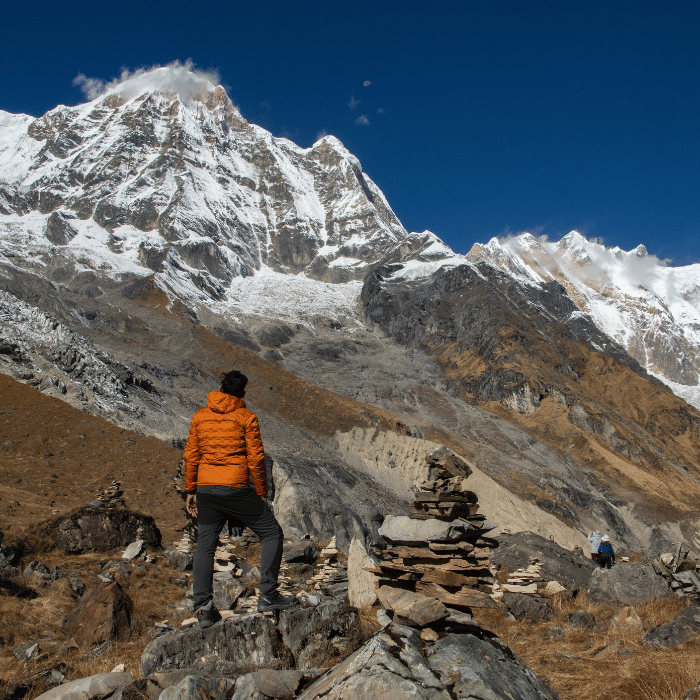
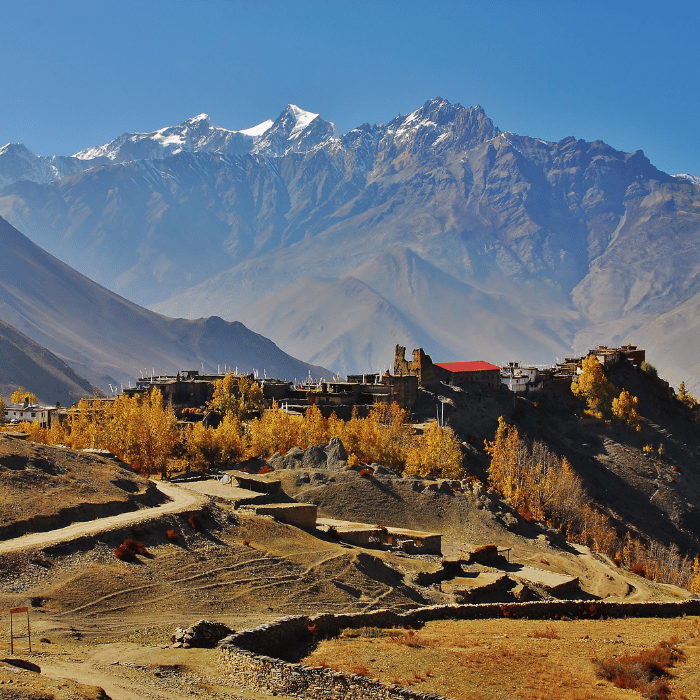
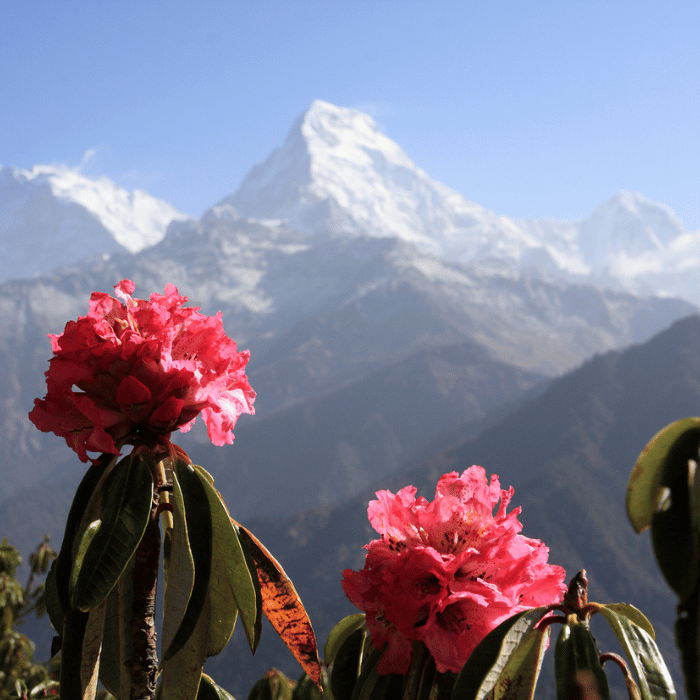
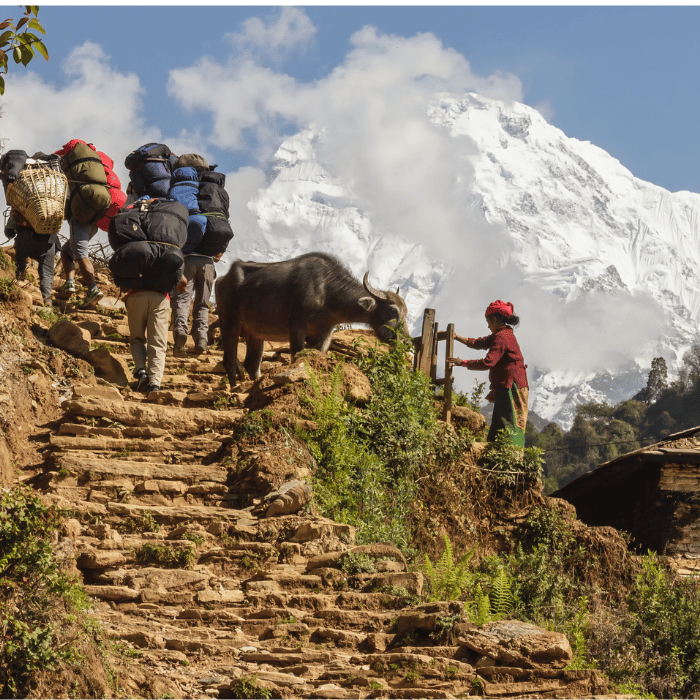
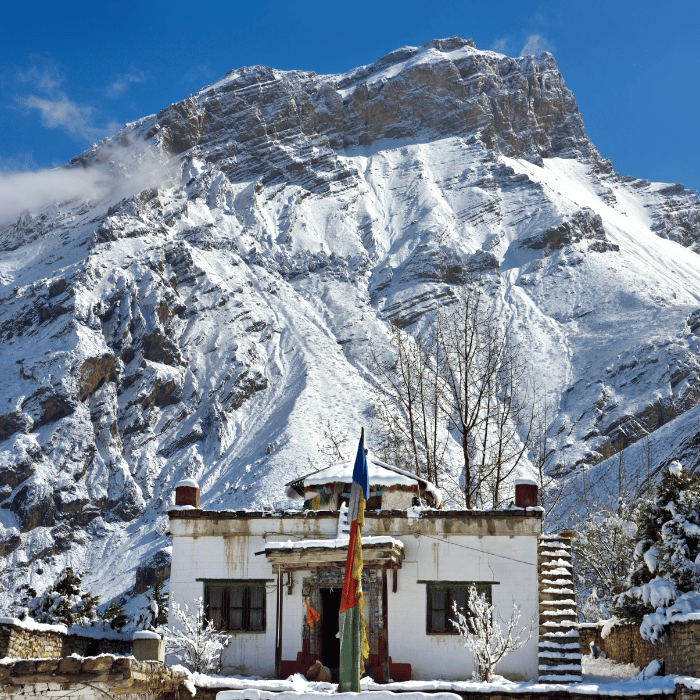


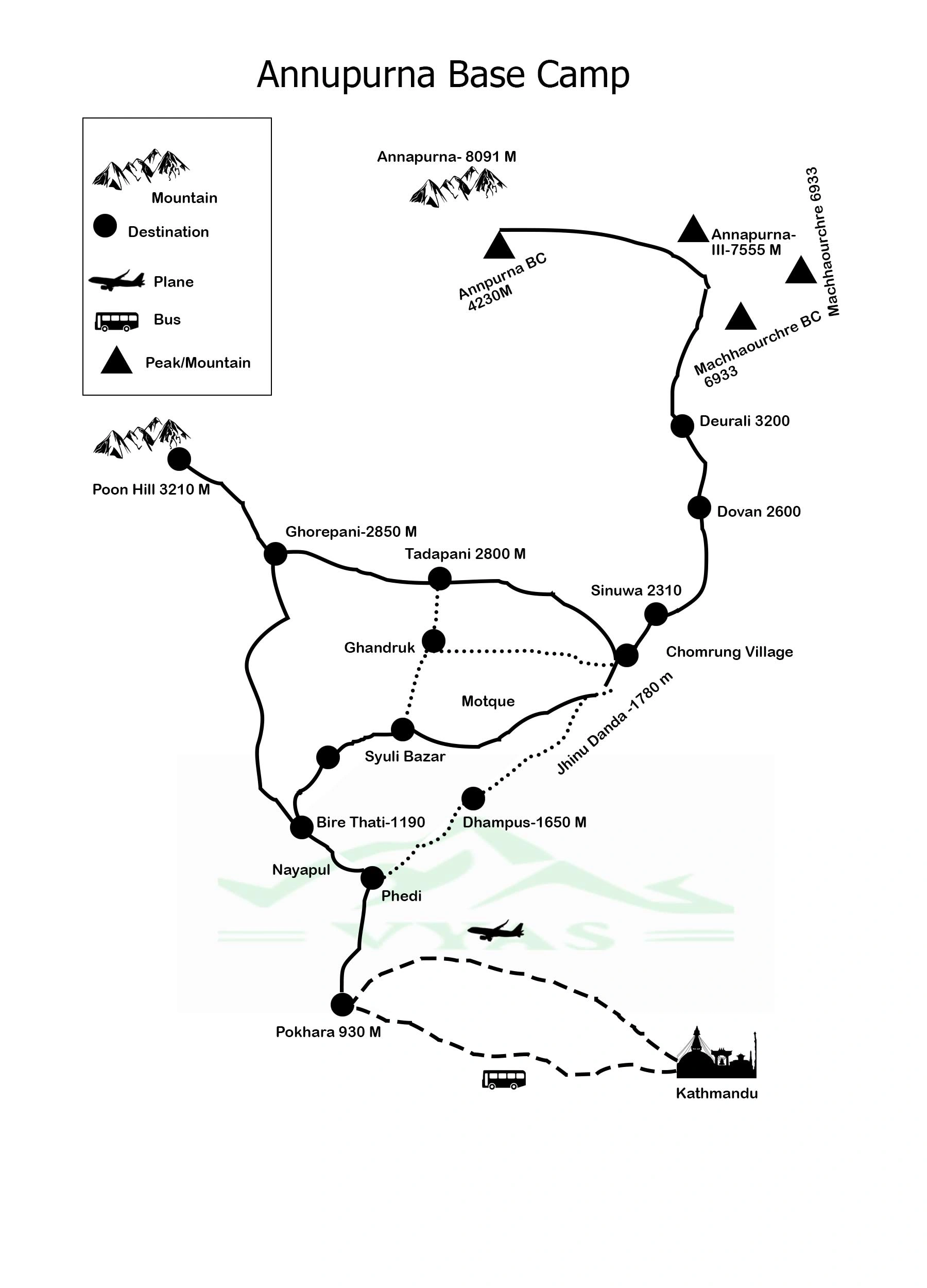






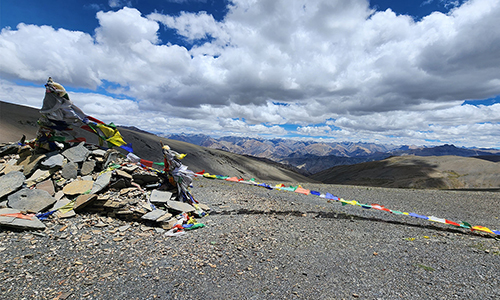

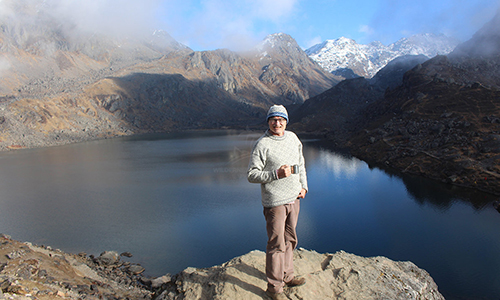


Jonathan Kim
2025-06-16 14:04:26
This truly is the world’s best trekking experience! The Annapurna Circuit with Vyas Trek Nepal took me through diverse landscapes, charming villages, and awe-inspiring mountain views. The team was knowledgeable, friendly, and supportive every step of the way. An unforgettable journey I’ll cherish forever